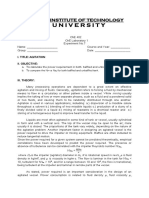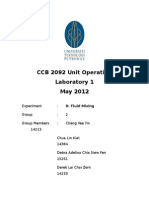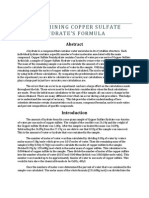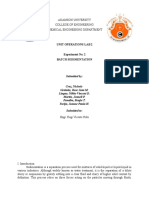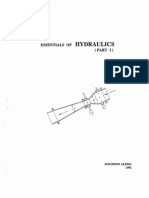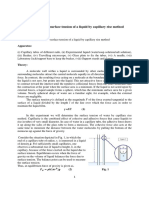Surface Tension
Surface Tension
Uploaded by
doulat2000Copyright:
Available Formats
Surface Tension
Surface Tension
Uploaded by
doulat2000Copyright
Available Formats
Share this document
Did you find this document useful?
Is this content inappropriate?
Copyright:
Available Formats
Surface Tension
Surface Tension
Uploaded by
doulat2000Copyright:
Available Formats
Experiment 1, page 1
Version of March 2, 2006
Experiment 446.1 SURFACE TENSION OF LIQUIDS
Theory To create a surface requires work that changes the Gibbs energy of a thermodynamic system. dG = SdT + VdP + dA (1.1) where is the surface tension, the free energy per unit surface area. Since a surface always involves two phases, the surface tension depends on the nature of the two substances between which the surface is formed. If surface segregation of material occurs in a solution, then the surface tension of the solution may depend on concentration in complex ways. Like other thermodynamic variables, surface tension depends on conditions such as the temperature. Eq. (1.1), for example, shows that the temperature derivative of is given by the following Maxwell equation: S (1.2) = A T T P where the derivative on the right is known as the surface entropy. One can evaluate the surface entropy by investigating the manner in which the surface tension varies with temperature. Reports of surface tension are often given for the situation in which the second phase is air or the vapor of the material. Thus, for example, at 20C, the reported surface tension of benzene against air is 28.85 dyne/cm, whereas the reported surface tension of benzene against its vapor is reported to be 28.89 dyne/cm. In Table 1.1 are data on the surface tension of water against air. Surface tensions for liquids against liquids are called interfacial tensions. Such interfacial tensions can be very different from the surface tensions of liquids against air. For example, the interfacial tension of water against benzene is 35 dyne/cm at 20C, whereas its value against air is 73.05 dyne/cm, and that of benzene against air is 28.85 dyne/cm. Surface tension produces several observable phenomena. The rise of a liquid in a capillary is the result of surface tension. The spreading of a film of oil on water is another example of the effect of surface tension, something first reported by Benjamin Franklin, although it probably was known in antiquity. Consider the simple situation depicted in Fig. 1.1, in which the end of a capillary tube of radius, r, is immersed in a liquid. For sufficiently small capillaries, one observes a substantial rise of liquid to height, h, in the capillary, because of the force exerted on the liquid due to surface tension. Equilibrium occurs when the force of gravity balances this force due to surface tension. The balance point can be used as a means to measure the surface tension: (2r ) = h (r 2 ) g (1.3)
Experiment 1, page 2
Version of March 2, 2006
Table 1.1. Density and Surface Tension of Water Against Air at Various Temperaturesa Temperature Density Temperature Density (gm/cm3) (gm/cm3) (C) (C) (dyne/cm) (dyne/cm) 0 0.99987 75.6 30 0.99567 71.18 5 0.99999 74.9 40 0.99224 69.56 10 0.99973 74.22 50 0.98807 67.91 15 0.99913 73.49 60 0.98324 66.18 18 0.99862 73.05 70 0.97781 64.4 20 0.99823 72.75 80 0.97183 62.6 25 0.99707 71.97 100 0.95838 58.9 a Source: R. C. Weast and M. J. Astle, Eds., CRC Handbook of Physics and Chemistry, 63rd Edition, CRC Press, Boca Raton, Florida, 1982. where r is the radius of the capillary, h is the capillary rise, is the liquid density, g is the acceleration due to gravity1, and is the surface tension of the liquid. Rearrangement gives a simple expression for the surface tension: 1 (1.4) = grh 2 A careful look at the boundary shows that the surface is not perfectly flat. Instead it curves up (or sometimes down) at the wall to form a meniscus, as shown in the inset in Fig. 1.1. The material in this region also contributes to the force of gravity, so one often finds a correction to Eq. (1.4) to yield
Figure 1. 1. Schematic diagram showing liquid rise in a capillary of radius r.
1 r g r (h + ) (1.5) 2 3 where the contact angle (the angle between the surface of the liquid and surface of the glass) has been assumed to be 0.
Figure 1.1. Capillary rise due to surface tension.
Procedure In this experiment you determine the surface tension of liquids against air by the method of capillary rise. To get good results, you must pay attention to cleanliness and procedure. If the
The standard acceleration due to gravity is defined by the International Committee on Weights and Measures to be 980.665 cm/sec2. Where exceptional accuracy is required, the acceleration due to gravity (in cm/sec2) at various places on the surface of the Earth can be found from Helmerts equation: g = 980.616 2.5928 cos (2) + 0.0069 cos2 (2) 3.08610-6 H, where is the latitude and H is the elevation above sea level in centimeters.
1
Experiment 1, page 3
Version of March 2, 2006
capillary tube has not been cleaned recently, it should be soaked in hot nitric acid for several minutes, following by washing with deionized water. The capillary should be stored in the polyethylene bottle containing deionized water when not in use. The apparatus is shown in Fig. 1.2. A test tube is fitted with a two-hole stopper. Through one hole is fitted the capillary tube (a length of a thermometer cut to expose the capillary at both ends). This is fitted through a glass sleeve and held in place by a piece of rubber tubing. In the second hole is a tube through which pressure or suction can be applied. This whole apparatus is immersed in a water bath to allow control of temperature. The water bath should be set initially at 251C (if room conditions allow). The measurement technique is straightforward. You use the cathetometer2 to determine the rise above the level of the material in the test tube. Record the height of the Figure 1.2. Schematic of the device for measuring liquid in the test tube and then the capillary rise. height of the liquid in the capillary; the difference of these is the capillary rise. Do this measurement at least four times on each sample. Each measurement should be made after the system is disturbed and allowed to return to equilibrium. Use the pressure/suction port or the top of the capillary to drive the system away from equilibrium in both directions. You should raise and lower the liquid in the capillary several times (by means of the suction and pressure) before making the first reading to ensure proper coating of the capillary walls. Be certain that the cathetometer is level and that the hair is set at the level of liquid in the test tube (and at the bottom of the meniscus for reading the height) in the capillary when making readings. Do not allow bubbles to form in the capillary, as this causes a substantial error in the reading of the capillary rise. Your result for each measurement will be an average of at least four evaluations for each sample at each temperture. Calibration of the apparatus is done by determining the capillary rise of deionized water, 1. for which the temperature-dependent surface tension is well known. Add enough water to the bottom of the test tube so that the bottom of the capillary can easily be immersed in it. Install the stopper with the capillary in it and clamp the whole setup so all parts of the apparatus containing water (including the water in the capillary) are immersed in the water bath. To bring water into the measurement vessel, open the two stopcocks on it
A cathetometer is a devise for precisely determining height. It consists of a telescope with crosshairs mounted on a graduated bar. By moving the telescope up and down to line the cross hairs with the point to be measured, one can read the height very precisely. Ask the laboratory instructor for instruction in reading the scale and focusing the instrument.
2
Experiment 1, page 4
Version of March 2, 2006
simultaneously. You may have to adjust the amount of openness of the bottom stopcock to make the water level stable, so watch it carefully. Wait a few minutes to allow everything to come to a constant temperature. Record the temperature of the bath from the thermometer, as well as the levels. Be careful with the water flow in the thermostatting bath. If the level rises, it will spill over onto the desk, making a mess. Adjust the bottom stopcock to create a steady level. You may have to change this as you change the temperature. When starting the flow, open BOTH stopcocks simultaneously. When shutting the system down, close BOTH stopcocks simultaneously.
2.
3.
Make measurements at a number of temperatures between 25 and 40C. Change the bath temperature slowly between experiments, allowing time for equilibration.3 Always allow time for thermal equilibration of the material before making a measurement. Measure the capillary rise of water and the alcohol assigned to you at each temperature, doing it first at a temperature near 25C. [Check with the laboratory instructor after you have determined the capillary rise of water at that temperature before you continue.] It is important that, when adding a new material, you rinse the capillary thoroughly. That means you have to add fresh material and pull it into the capillary several times. Repeat this with three aliquots of material. After the third rinse, make a set of repeated measurements of the capillary rise. After all measurements are made, rinse the capillary thoroughly with deionized water and replace it in the storage tank. The final state of the water bath should be near 25C.
Table 1.2. Density of Alcohols at Various Temperatures (gm/cm3) Methanol Ethanol Propanol Temperature (C) 0 0.8100 0.8065 0.8193 10 0.8008 0.7979 20 0.7915 0.7894 0.8035 30 0.7825 0.7810 40 0.7740 0.7722 0.7875 50 0.7650 0.7633 60 0.7555 0.7541 0.7700 70 0.7460 0.7446 80 0.7355 0.7348 0.7520 90 0.7250 0.7251 0.7425 100 0.7140 0.7157 0.7325 Source: H. Landolt, R. Boernstein and W. Roth, Physikalische-Chemische Tabellen, Springer Verlag, Berlin, 1912, 5. Auflage.
I advise you to make all measurements at a particular temperature before changing to another temperature; the water is used as a calibration. If you are measuring a particular alcohol at several temperatures, measure the water at each temperature as you go, rather than doing all of the water measurements at different temperatures first. This saves time because heating the water bath is the rate-limiting step.
Experiment 1, page 5
Version of March 2, 2006
Calculations 1. For each measurement on water and the alcohol, calculate the average and standard deviation of the capillary rise. It is convenient to report rises along with the associated error as a function of temperature for water and the alcohol in a table. 2. Use the results for water and its known surface tension to determine the effective radius of the capillary at each temperature with equation (1.4). [You should interpolate to obtain the density at the conditions appropriate to your measurements.] 3. Use Eq. (1.5) to estimate the radius of the capillary from the water data. Does this equation give a value that is measurably different from that by using equation (1.4)? Explain the answer. If it is different, then use Eq. (1.5) in the following calculations. If not, you may use equation (1.4) in what follows. 4. Using the known densities of water and the alcohol assigned to you, calculate the surface tension of the alcohol at the various temperatures with either Eq. (1.4) or (1.5), whichever is appropriate. Assume the known surface tension of water allows a calibration of the apparatus at each temperature. Be sure to report uncertainty. 5. From the data on the surface tension of the alcohol as a function of temperature, determine the surface entropy. 6. Determine the surface energy of the alcohol at each temperature at which you made a measurement. Discussion Questions 1. Compare your data to literature data for the surface tension of the alcohol. [This means you have to spend some time in the library looking through books to find old measurements!] 2. Did you notice any effect of hysteresis in this apparatus? Explain your answer. 3. Does the surface entropy of your alcohol depend on temperature? Explain. 4. Describe changes you might make in the design of the experiment to make the measurement more precise. Explain your reasoning. 5. Is the surface tension of an alcohol higher or lower than that of water? Give a possible physical reason why this is so. 6. What is a contact angle? In this experiment, what contact angle does one have or assume? How will this assumption affect the results? Is it important? 7. Briefly describe (in one paragraph) other methods one might use to measure surface tension of a liquid against air.
You might also like
- CHM170L - Final Report 3Document5 pagesCHM170L - Final Report 3Katrina BucudNo ratings yet
- Lab Report 1 Diffusion Across Biological Membrances SimulationDocument7 pagesLab Report 1 Diffusion Across Biological Membrances SimulationAmeena Ali50% (2)
- Chee3005 Prac 1Document9 pagesChee3005 Prac 1MolloyNo ratings yet
- CHE Thermodynamics Competency Exam 2013 - 20141 EditedDocument7 pagesCHE Thermodynamics Competency Exam 2013 - 20141 EditedWinsletJoyDauagNo ratings yet
- Problem Set - Particle Fluid Separation2012Document3 pagesProblem Set - Particle Fluid Separation2012John Kevin San Jose50% (2)
- Sorrel ExtractionDocument20 pagesSorrel ExtractionKid ArachnidNo ratings yet
- 1180 Exp 04, Density and Specific GravityDocument13 pages1180 Exp 04, Density and Specific GravityShaniCoolestNo ratings yet
- CHFEN 3553 Chemical Reaction Engineering: April 28, 2003 1:00 PM - 3:00 PM Answer All QuestionsDocument4 pagesCHFEN 3553 Chemical Reaction Engineering: April 28, 2003 1:00 PM - 3:00 PM Answer All QuestionsJiahui TanNo ratings yet
- Hydrodynamics of Packed ColomnDocument6 pagesHydrodynamics of Packed ColomnDhananjay KadamNo ratings yet
- CHM170L Exp2 DensityDocument6 pagesCHM170L Exp2 DensityKaiser SaltoNo ratings yet
- Liquid Diffusion Coefficient Apparatus BP09Document4 pagesLiquid Diffusion Coefficient Apparatus BP09Ahmed AliNo ratings yet
- Screen 2Document3 pagesScreen 2Ramon Dela CruzNo ratings yet
- Sedimentation (Engineering Notes)Document24 pagesSedimentation (Engineering Notes)meeraNo ratings yet
- AgitationDocument4 pagesAgitationEileenNo ratings yet
- Gas AbsorptionDocument33 pagesGas Absorptionirfan hilmanNo ratings yet
- Final Report PFRDocument12 pagesFinal Report PFRmark_ancotNo ratings yet
- Particle Characterization and Size Reduction: LecturerDocument34 pagesParticle Characterization and Size Reduction: LecturerJane Eilyza AballaNo ratings yet
- PDFDocument88 pagesPDFMuralidharanNo ratings yet
- Laboratory Activity 2 Measuring Density and Viscosities of Different FluidsDocument5 pagesLaboratory Activity 2 Measuring Density and Viscosities of Different FluidsJohn Patrick Sanay NunezNo ratings yet
- Experiment8 Fluid MixingDocument28 pagesExperiment8 Fluid MixingZen AlkaffNo ratings yet
- Sucrose Inversion Experiment - DraftDocument7 pagesSucrose Inversion Experiment - DraftRos Vincent AlvarezNo ratings yet
- Mto Lab Manuals - All ExperimentsDocument121 pagesMto Lab Manuals - All ExperimentsAnmol JainNo ratings yet
- Cre 1 IntroductionDocument4 pagesCre 1 IntroductionEvangeline LauNo ratings yet
- f2 Sedimentation Practical Report For s3 LevelDocument17 pagesf2 Sedimentation Practical Report For s3 Levelbaddierobie12No ratings yet
- Experiment 9Document6 pagesExperiment 9Muzammil Iqbal100% (1)
- Growth Rate and Yield Calculations - 17.11.16Document10 pagesGrowth Rate and Yield Calculations - 17.11.16Raghav Suresh100% (1)
- Centrifugal Separation Processess: Prepared by Engr. Sandra Enn BahintingDocument31 pagesCentrifugal Separation Processess: Prepared by Engr. Sandra Enn BahintingSandra Enn BahintingNo ratings yet
- 04 First Law of ThermodynamicsDocument33 pages04 First Law of ThermodynamicsLuthfiani Widyawati Dwi AntariNo ratings yet
- LAB READINESS-LEACHING v2Document7 pagesLAB READINESS-LEACHING v2Jabin Sta. TeresaNo ratings yet
- What Is The Difference Between Diffusion and Radiation Heat TransferDocument9 pagesWhat Is The Difference Between Diffusion and Radiation Heat TransferKhalid AlmashikhiNo ratings yet
- Fluid Flow Through Packed BedDocument9 pagesFluid Flow Through Packed BedAmartya MitraNo ratings yet
- Cheng 323 Chap 4Document82 pagesCheng 323 Chap 4Faisal Mumtaz100% (2)
- What Is Activation OverpotentialDocument1 pageWhat Is Activation OverpotentialMuhammad RiaanNo ratings yet
- Humidification and Air Conditioning: Lecture No. 8Document6 pagesHumidification and Air Conditioning: Lecture No. 8Anonymous UFa1z9XUANo ratings yet
- Appendix C: Multiple Choice Questions..: Cus O H O H O H ODocument27 pagesAppendix C: Multiple Choice Questions..: Cus O H O H O H OVitória FreireNo ratings yet
- Partial Molar VolumeDocument4 pagesPartial Molar VolumeCorine CaracasNo ratings yet
- Assignment L01 (Thursday, 11.30 Am) Marking SchemeDocument12 pagesAssignment L01 (Thursday, 11.30 Am) Marking SchemeMawareNo ratings yet
- Batch Distillation ExperimentDocument8 pagesBatch Distillation ExperimentJonelou CusipagNo ratings yet
- Department of Chemical Engineering University of San Carlos Nasipit, Talamban, Cebu CityDocument7 pagesDepartment of Chemical Engineering University of San Carlos Nasipit, Talamban, Cebu CityJan Rommel DuterteNo ratings yet
- rr310802 Chemical Engineering Thermodynamics IIDocument8 pagesrr310802 Chemical Engineering Thermodynamics IISRINIVASA RAO GANTANo ratings yet
- Heat Capacity of GasesDocument9 pagesHeat Capacity of Gasesismail100% (1)
- Drying ExperimentDocument10 pagesDrying ExperimentKris Dominic RubillosNo ratings yet
- 10.2 Thermo ProbsetDocument20 pages10.2 Thermo ProbsetJan Rommel DuterteNo ratings yet
- Heat 4e Chap11 LectureDocument32 pagesHeat 4e Chap11 LectureSalim ChohanNo ratings yet
- ChE 413 Tutorials Problem Set 7-5-16 Solid State Chemistry and Bonding PDFDocument1 pageChE 413 Tutorials Problem Set 7-5-16 Solid State Chemistry and Bonding PDFNika A. BungabongNo ratings yet
- CHE4162 Particle Technology November 2010 Exam SolutionsDocument14 pagesCHE4162 Particle Technology November 2010 Exam SolutionsPa1 Kumar M100% (1)
- Branching Applications: Ch.E. 412: Topic 2dDocument25 pagesBranching Applications: Ch.E. 412: Topic 2dAriana ReligiosoNo ratings yet
- PFR ReactorDocument19 pagesPFR Reactorkhairi100% (2)
- Experiment No,-3 (A) : Mass Transfer Lab IIT KGPDocument3 pagesExperiment No,-3 (A) : Mass Transfer Lab IIT KGPSiddharth MohapatraNo ratings yet
- Gas Diffusion UnitDocument20 pagesGas Diffusion Unitsolehah misniNo ratings yet
- Lab Report 1Document5 pagesLab Report 1Marlaina WilliamsNo ratings yet
- IYOHA COLLINS 16CF020531 Batch Reactor ReportDocument19 pagesIYOHA COLLINS 16CF020531 Batch Reactor ReportDavid OvieNo ratings yet
- SedimentationDocument7 pagesSedimentationgrkhari1100% (2)
- SedimentationDocument9 pagesSedimentationAutumn JohnsonNo ratings yet
- Introductory Applications of Partial Differential Equations: With Emphasis on Wave Propagation and DiffusionFrom EverandIntroductory Applications of Partial Differential Equations: With Emphasis on Wave Propagation and DiffusionNo ratings yet
- SURFACE TENSION OF PURE LIQUIDS AND SOLUTIONS Lab Report (Bacsarpa, XJ)Document7 pagesSURFACE TENSION OF PURE LIQUIDS AND SOLUTIONS Lab Report (Bacsarpa, XJ)Xena Jenn Y. BacsarpaNo ratings yet
- Surface Tension and Molar Surface Free Energy and Entropy of Water To - 27.2Document4 pagesSurface Tension and Molar Surface Free Energy and Entropy of Water To - 27.2ANGELICA ALEJANDRA MORENO CONTEREASNo ratings yet
- Practical Report Submission Group 1_215015134_attempt_2021-06-30-19-58-49_215015134Document29 pagesPractical Report Submission Group 1_215015134_attempt_2021-06-30-19-58-49_215015134TshepoNo ratings yet
- Fluid Mechanics ManualDocument36 pagesFluid Mechanics ManualHarold Taylor100% (1)
- Capillary Rise in Sands and SiltsDocument3 pagesCapillary Rise in Sands and SiltsTecnohidro Engenharia AmbientalNo ratings yet
- Surface PhenomenaDocument16 pagesSurface PhenomenaJian LiangNo ratings yet
- Fluid Mechanics: Presented By: Engr. Franz D. SantosDocument68 pagesFluid Mechanics: Presented By: Engr. Franz D. Santoserick oracionNo ratings yet
- Canal Irrigation System: Chapter No 03 by Santosh Kumar GargDocument61 pagesCanal Irrigation System: Chapter No 03 by Santosh Kumar GargEllie BrooklynNo ratings yet
- B 7411 PDFDocument22 pagesB 7411 PDFAugustinNo ratings yet
- Modeling Phenomena O... by Jacob Bear (Auth.) (Z-Lib - Org) - 389-468Document80 pagesModeling Phenomena O... by Jacob Bear (Auth.) (Z-Lib - Org) - 389-468Бунёд ИмомназаровNo ratings yet
- Unsaturated Soil Mechanics: Fundamental Challenges, Breakthroughs, and OpportunitiesDocument9 pagesUnsaturated Soil Mechanics: Fundamental Challenges, Breakthroughs, and OpportunitiesgeotecnhniqueNo ratings yet
- Thermodynamic Aspects of Heat Pipe Operation 1994 USADocument7 pagesThermodynamic Aspects of Heat Pipe Operation 1994 USASanjeet KumarNo ratings yet
- Surface TensionDocument4 pagesSurface TensionMD AJMALNo ratings yet
- ASTM D4772 Water Absorption PaperDocument10 pagesASTM D4772 Water Absorption PaperGeorge Vekinis100% (1)
- Experiment 1 Online 1Document1 pageExperiment 1 Online 1Clarence BautistaNo ratings yet
- Buchgraber 2012Document22 pagesBuchgraber 2012Javier E. Guerrero ArrietaNo ratings yet
- Physics 1: Kaunas University of TechnologyDocument5 pagesPhysics 1: Kaunas University of TechnologyLuckyOne--No ratings yet
- Essentials of Hydraulics - DrSolomon Chapters 1 - 3Document135 pagesEssentials of Hydraulics - DrSolomon Chapters 1 - 3Jôssŷ FkrNo ratings yet
- Atlas of Human Anatomy by Mark Nielsen Shawn Miller 2024 Scribd DownloadDocument24 pagesAtlas of Human Anatomy by Mark Nielsen Shawn Miller 2024 Scribd Downloadnacerabahau98100% (1)
- Evaporation Analysis in Sintered Wick MicrostructuresDocument13 pagesEvaporation Analysis in Sintered Wick MicrostructuresArley Salazar HincapieNo ratings yet
- Doubtnut Question BankDocument801 pagesDoubtnut Question Banksonyharley5No ratings yet
- Physics Investigatory ProjectDocument10 pagesPhysics Investigatory ProjectShlok Chandak100% (1)
- Part Test 16Document20 pagesPart Test 16Rishav SinglaNo ratings yet
- Wicking Properties of High Twist Pet Crepe Fabrics: K. NassarDocument7 pagesWicking Properties of High Twist Pet Crepe Fabrics: K. NassarDurgesh TripathiNo ratings yet
- 12.04.20 Sr.N-SUPERCHAINA Jee Adv 2019 P1 GTA-10 P-1 QPDocument18 pages12.04.20 Sr.N-SUPERCHAINA Jee Adv 2019 P1 GTA-10 P-1 QPAkhilesh Kumar PathakNo ratings yet
- Surface Tension by Capillary Rise Method - 2018Document4 pagesSurface Tension by Capillary Rise Method - 2018Zayn AhmedNo ratings yet
- Ce 140 - Hydraulics: By: Paul Rommel R. Valencia, Ce, MameDocument15 pagesCe 140 - Hydraulics: By: Paul Rommel R. Valencia, Ce, MameRochelleNo ratings yet
- Fluid Mechanics - Resource BookDocument167 pagesFluid Mechanics - Resource BookAkshat ModiNo ratings yet
- BFC 10403 Fluid Mechanics: Noor Aliza AhmadDocument58 pagesBFC 10403 Fluid Mechanics: Noor Aliza AhmadZhi Lin TanNo ratings yet
- Conceptual Design of A Condensing Heat Exchanger For Space Systems Using Porous MediaDocument13 pagesConceptual Design of A Condensing Heat Exchanger For Space Systems Using Porous MediaalirafiqNo ratings yet
- Applied Colloid and Surface ChemistryDocument190 pagesApplied Colloid and Surface Chemistrycirorfj100% (3)
- QUS 103 - Basic Engineering Science (Theory)Document58 pagesQUS 103 - Basic Engineering Science (Theory)Thapa Gorkha100% (11)
- (P) Properties of Matter-ExerciseDocument28 pages(P) Properties of Matter-ExerciseSocial Credits Positive Million AspirantNo ratings yet
- Phy 1Document10 pagesPhy 1Garlapati Srinivasa RaoNo ratings yet














